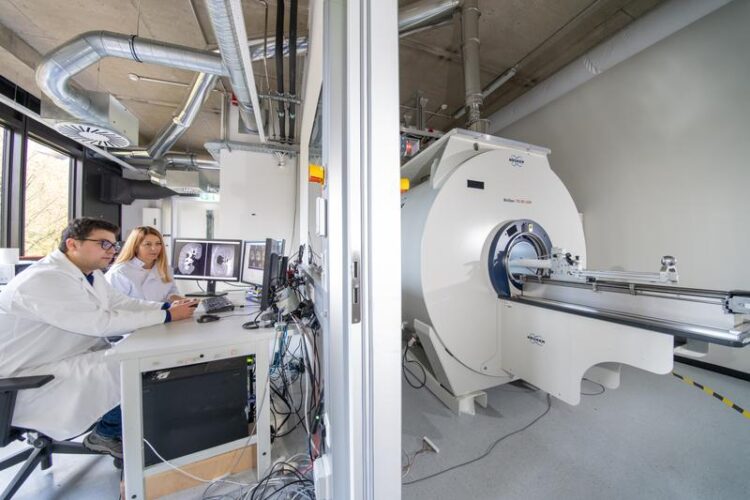Diamond dust shines bright in Magnetic Resonance Imaging

Dr. Jelena Lazovic Zinnanti (right) and a colleague working with MRI
Copyright: MPI for Intelligent Systems / W. Scheible
Potential alternative to widely used contrast agent gadolinium.
Some of the world’s greatest discoveries happened by accident. While the discovery of diamond dust’s potential as a future MRI contrast agent may never be considered a turning point in science history, its signal-enhancing properties are nevertheless an unexpected finding which may open-up new possibilities: Diamond dust glows brightly even after days of being injected. Does that mean it could perhaps one day become an alternative to the widely used contrast agent gadolinium?
This heavy metal is used in clinics to detect tumors, inflammation, or vascular abnormalities for more than 30 years. It enhances the brightness of the image of affected areas. However, when injected into a patient’s bloodstream, gadolinium travels not only to tumor tissue but also to surrounding healthy tissue. It is retained in the brain and kidneys, persisting months to years after the last administration. The long-term effects on the patient are not yet known. Gadolinium also causes a number of other side effects. The search for an alternative has been underway for years.
Could diamond dust, a carbon-based material, become a well-tolerable alternative because of an unexpected discovery made in a laboratory at the Max Planck Institute for Intelligent Systems in Stuttgart?
Dr. Jelena Lazovic Zinnanti was working on an experiment using nanometer-sized diamond particles for an entirely different purpose. The research scientist, who heads the Central Scientific Facility Medical Systems at MPI-IS, was surprised when she put the 3 to 5 nanometer particles into tiny drug-delivery capsules made of gelatin. She wanted these capsules to rupture when exposed to heat. She assumed that diamond dust, with its high heat capacity, could help.
“I had intended to use the dust only to heat up the drug carrying capsules,” Jelena recollects. “I used gadolinium to track the dust particles’ position. I intended to learn if the capsules with diamonds inside would heat up better. While performing preliminary tests, I got frustrated, because gadolinium would leak out of the gelatin – just as it leaks out of the bloodstream into the tissue of a patient. I decided to leave gadolinium out. When I took MRI images a few days later, to my surprise, the capsules were still bright. Wow, this is interesting, I thought! The diamond dust seemed to have better signal enhancing properties than gadolinium. I hadn’t expected that.”
Jelena took these findings further by injecting the diamond dust into live chicken embryos. She discovered that while gadolinium diffuses everywhere, the diamond nanoparticles stayed in the blood vessels, didn’t leak out and later shone brightly in the MRI, just as they had done in the gelatin capsules. While other scientists had published papers showing how they used diamond particles attached to gadolinium for magnetic resonance imaging, no one had ever shown that diamond dust itself could be a contrast agent.
Two years later, Jelena became the lead author of a paper now published in Advanced Materials.
“Why the diamond dust shines bright in our MRI still remains a mystery to us,” says Jelena, who worked with Prof. Metin Sitti and researchers from the Physical Intelligence Department at MPI-IS and with Dr. Eberhard Goering from the MPI-IS’ neighboring institute, the MPI for Solid State Research. She can only assume the reason for the dust’s magnetic properties: “I think the tiny particles have carbons that are slightly paramagnetic. The particles may have a defect in their crystal lattice, making them slightly magnetic. That’s why they behave like a T1 contrast agent such as gadolinium. Additionally, we don’t know whether diamond dust could potentially be toxic, something that needs to be carefully examined in the future.”
If diamond dust is found to be safe and well tolerated by patients, Jelena believes it has the potential to become a new contrast agent option for future MRI scans, where it would be deposited in tissue with abnormal vasculature, such as tumors, but not in healthy tissue.
Nanodiamond-Enhanced Magnetic Resonance Imaging (Adv. Mater. 11/2024)
Jelena Lazovic, Eberhard Goering, Anna-Maria Wild, Peter Schützendübe, Anitha Shiva, Jessica Löffler, Gordon Winter, Metin Sitti
First published: 14 March 2024
https://doi.org/10.1002/adma.202470085
Journal: Advanced Materials
DOI: 10.1002/adma.202470085
Method of Research: Experimental study
Subject of Research: Not applicable
Article Title: Nanodiamond-Enhanced Magnetic Resonance Imaging
Article Publication Date: 14-Mar-2024
Media Contact
Linda Behringer
Max Planck Institute for Intelligent Systems
linda.behringer@is.mpg.de
Cell: 151-230-01111
Original Source
https://onlinelibrary.wiley.com/doi/10.1002/adma.202470085?af=R
Media Contact
All latest news from the category: Materials Sciences
Materials management deals with the research, development, manufacturing and processing of raw and industrial materials. Key aspects here are biological and medical issues, which play an increasingly important role in this field.
innovations-report offers in-depth articles related to the development and application of materials and the structure and properties of new materials.
Newest articles
Faster, more energy-efficient way to manufacture an industrially important chemical
Zirconium combined with silicon nitride enhances the conversion of propane — present in natural gas — needed to create in-demand plastic, polypropylene. Polypropylene is a common type of plastic found…

Energy planning in Ghana as a role model for the world
Improving the resilience of energy systems in the Global South. What criteria should we use to better plan for resilient energy systems? How do socio-economic, technical and climate change related…

Artificial blood vessels could improve heart bypass outcomes
Artificial blood vessels could improve heart bypass outcomes. 3D-printed blood vessels, which closely mimic the properties of human veins, could transform the treatment of cardiovascular diseases. Strong, flexible, gel-like tubes…





















